Your step by step guide on how to turn a bubbling sourdough starter into dry form so you can easily mail it, share it or put it on hold. A dehydrated active sourdough starter will keep indefinitely and can be revived and ready to use to make bread in less than a week.
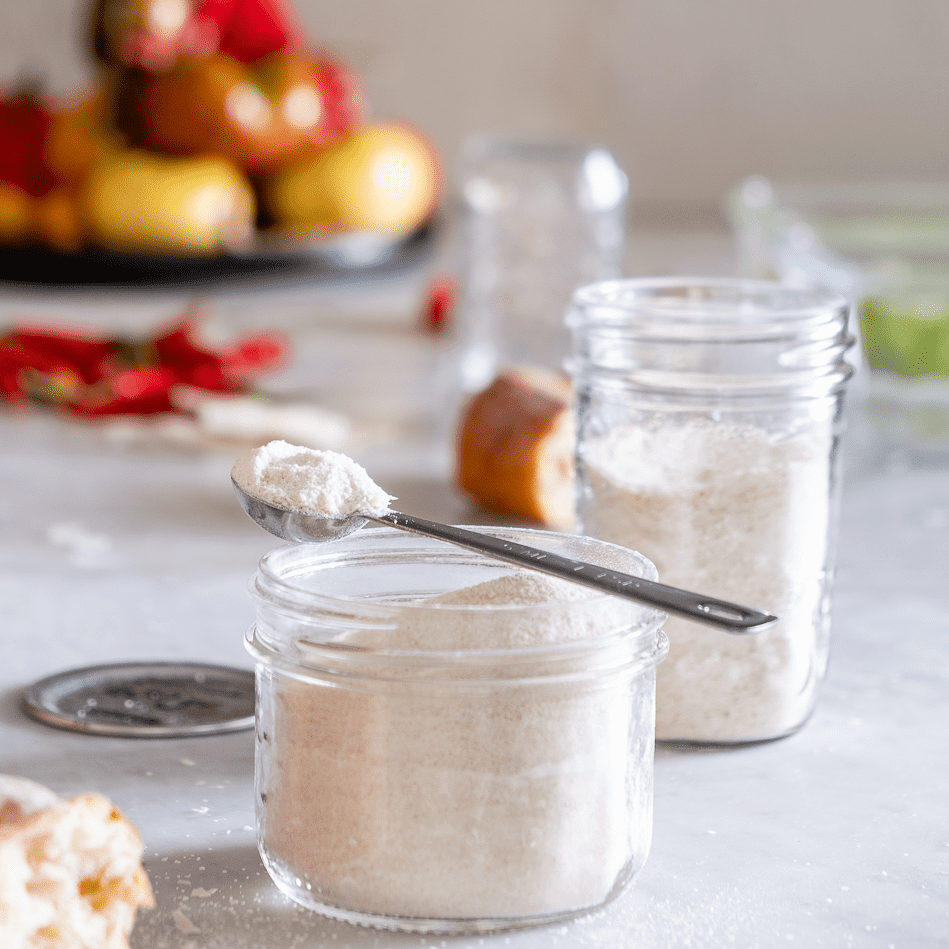
Warm weather usually means spending more time outdoors and less time inside feeding and fretting over your perpetually hungry sourdough starter.
By the time April rolls around most of the casual sourdough bakers out there (me) are getting pretty sick of buying massive bags of flour and feeding the blob.
It takes a while to create a very active sourdough starter from scratch so it's always disappointing when you accidentally on purpose kill it from neglect because you're sick of caring for it.
Instead of sticking the starter in your fridge where it will eventually be lost and grow mouldy behind a 9 year old bottle of Oyster sauce, you should dry your starter to preserve it for using later.
You can literally put your starter on hold so it requires NO care at all.
Table of Contents
What is dry sourdough starter?
Dry sourdough starter is exactly what it sounds like; it is sourdough starter that has been dried at a low temperature to preserve the live ingredients: lactic acid bacteria and wild yeasts.
Like a hibernating bear, the starter is still very much alive after drying, it's just sleeping. When the time comes to wake it up all you have to do is feed it. Within days it will be as strong as the original was.
To make a dehydrated sourdough starter, you first need an active, bubbling starter.
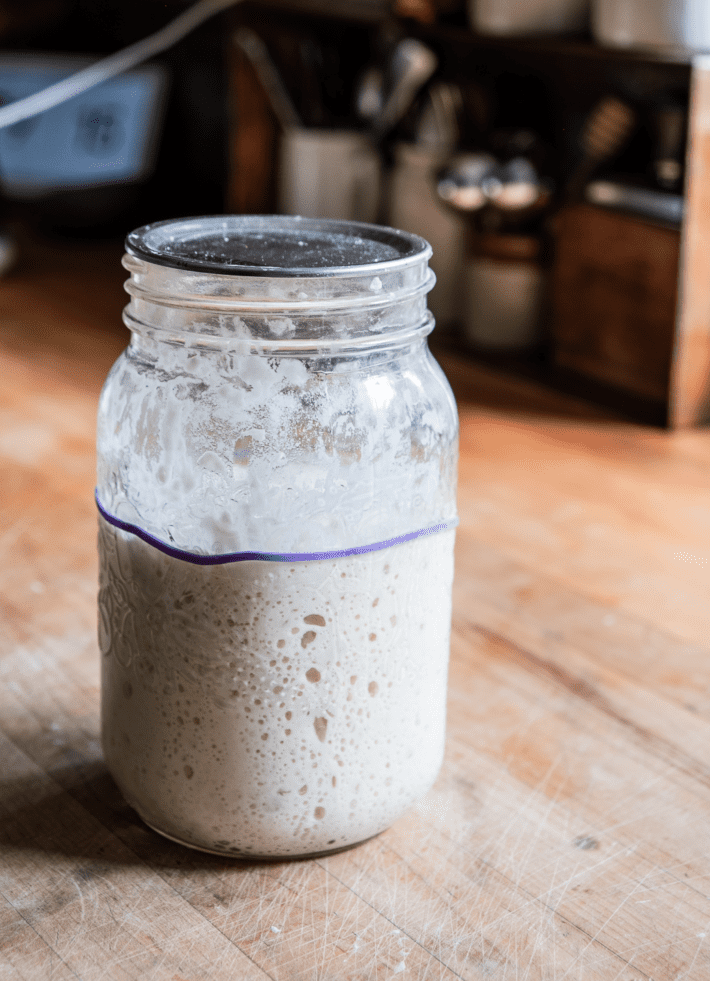
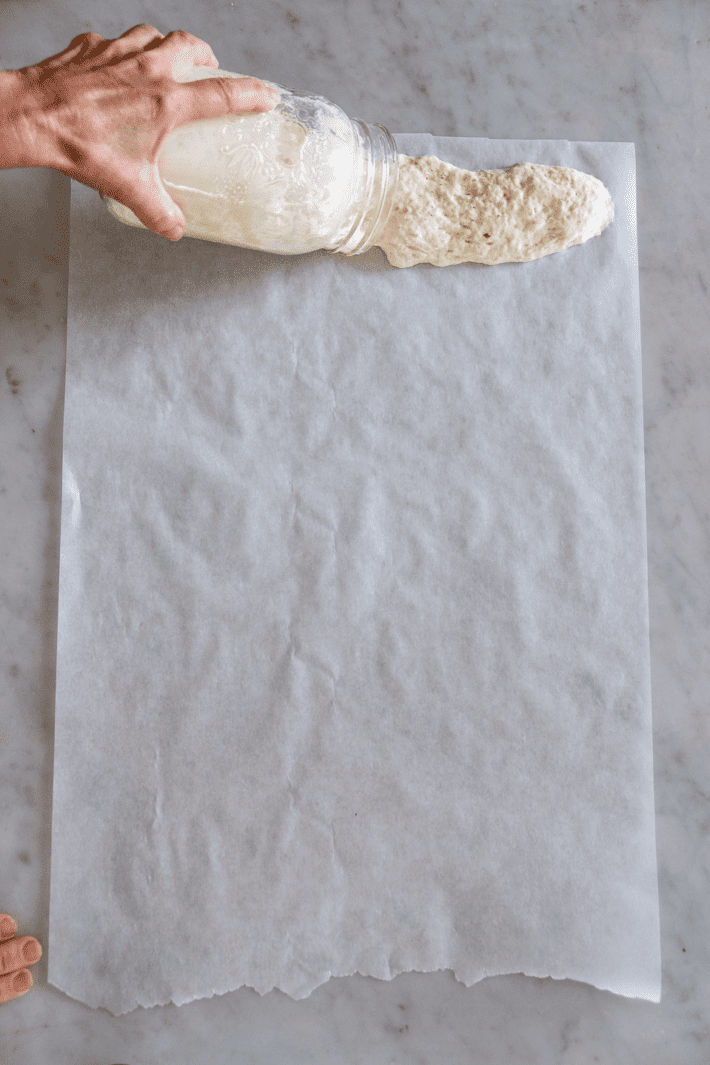
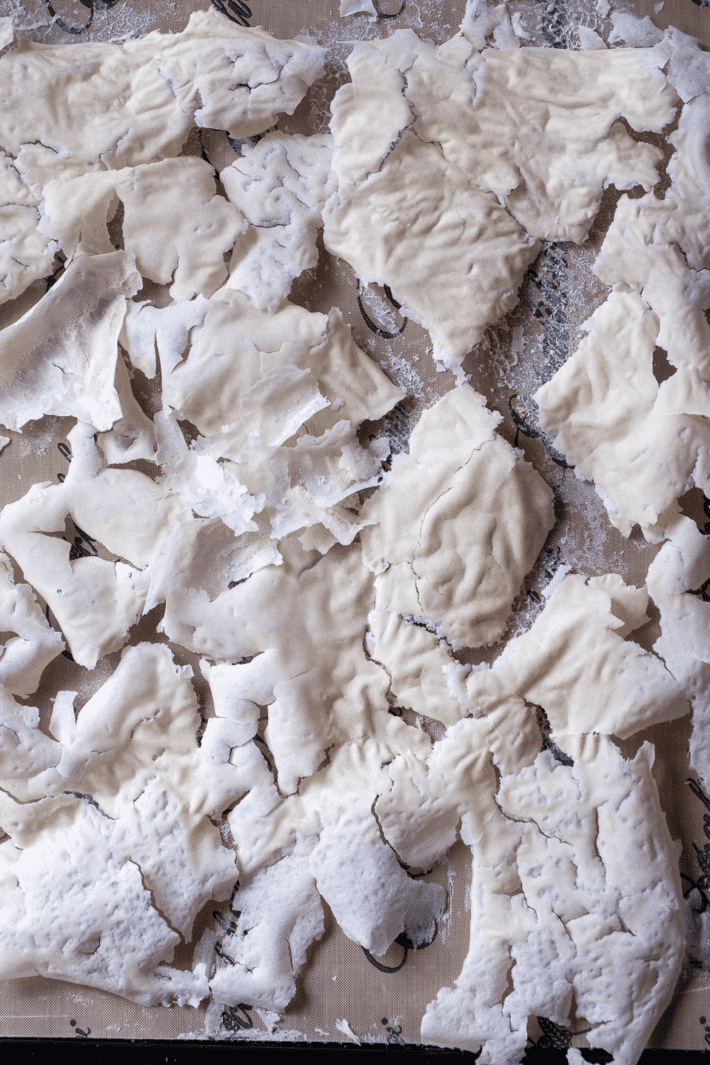
This post is based on the assumption that you have a sourdough starter you want to preserve. If you don't, it's time to find a friend who has one and will give you some for drying.
How to dry sourdough starter
Time required: 6-12 hours depending on room temperature and how thin the starter is spread out.
- Always start with an active starter that's at its peak. If your wet starter is weak or hungry, feed it for a few days until it's nice and active and the yeast colony is as big and bustling as possible.
- While it's at its peak, (the point you would make bread with it) pour your active wet sourdough starter onto a sheet of parchment paper or directly onto a solid surface like a stone countertop.
- Drag and pull a bench scraper across the bubbly starter to flatten and spread it over the paper.
- Repeat until all the starter is spread into a thin layer. Keep it as uniformly thin as you can so it all dries quickly and at the same time.
- Leave it in a warm room until fully dried and brittle. Humidity will slow down the process.*
*Winter or early spring is the best time to do this because you won't be battling fruit flies trying to land, walk and mate on your starter. By the way, one of my best posts ever is my DIY fruit fly trap. It's worth the read just to see my counting dead fruit flies.
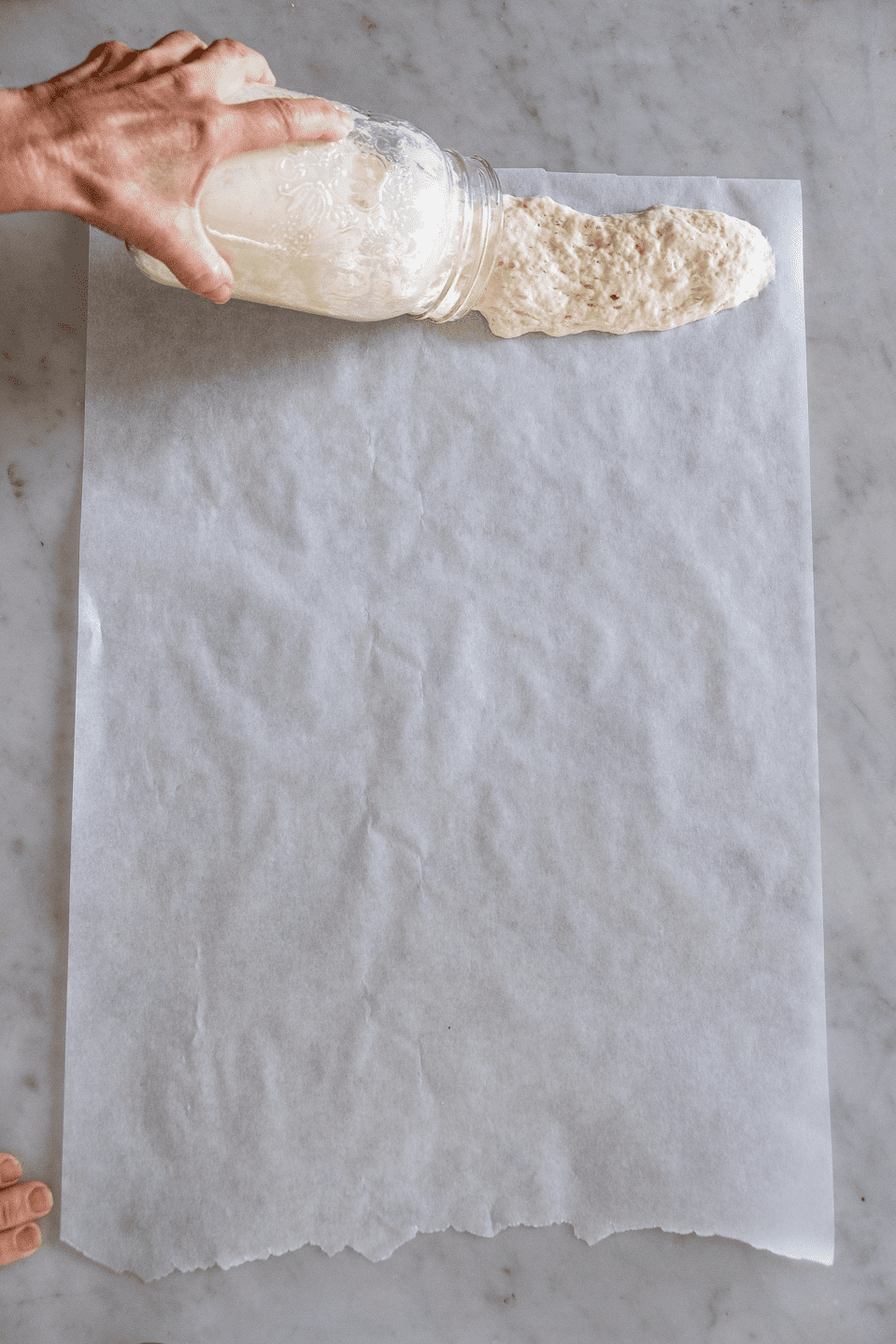
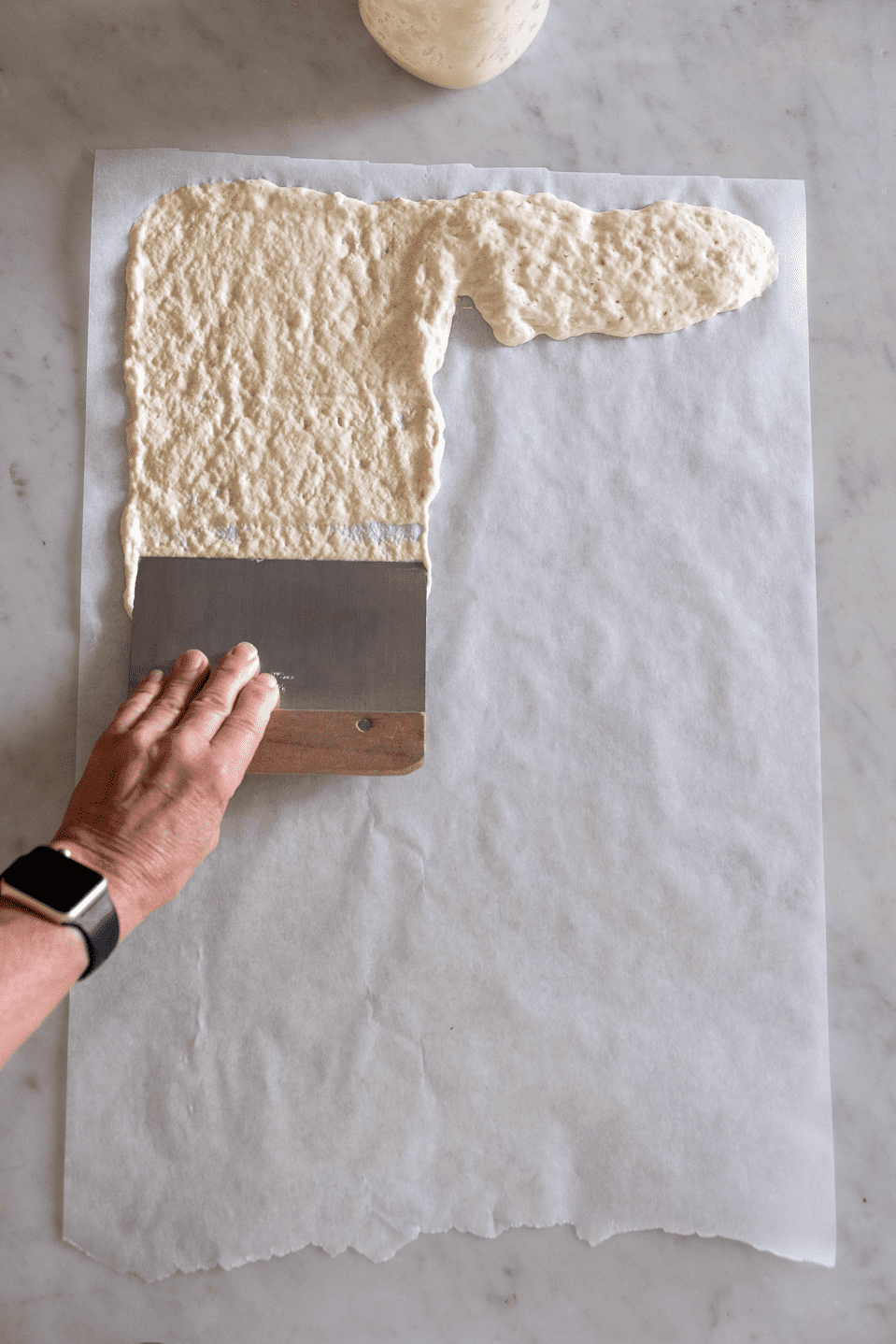
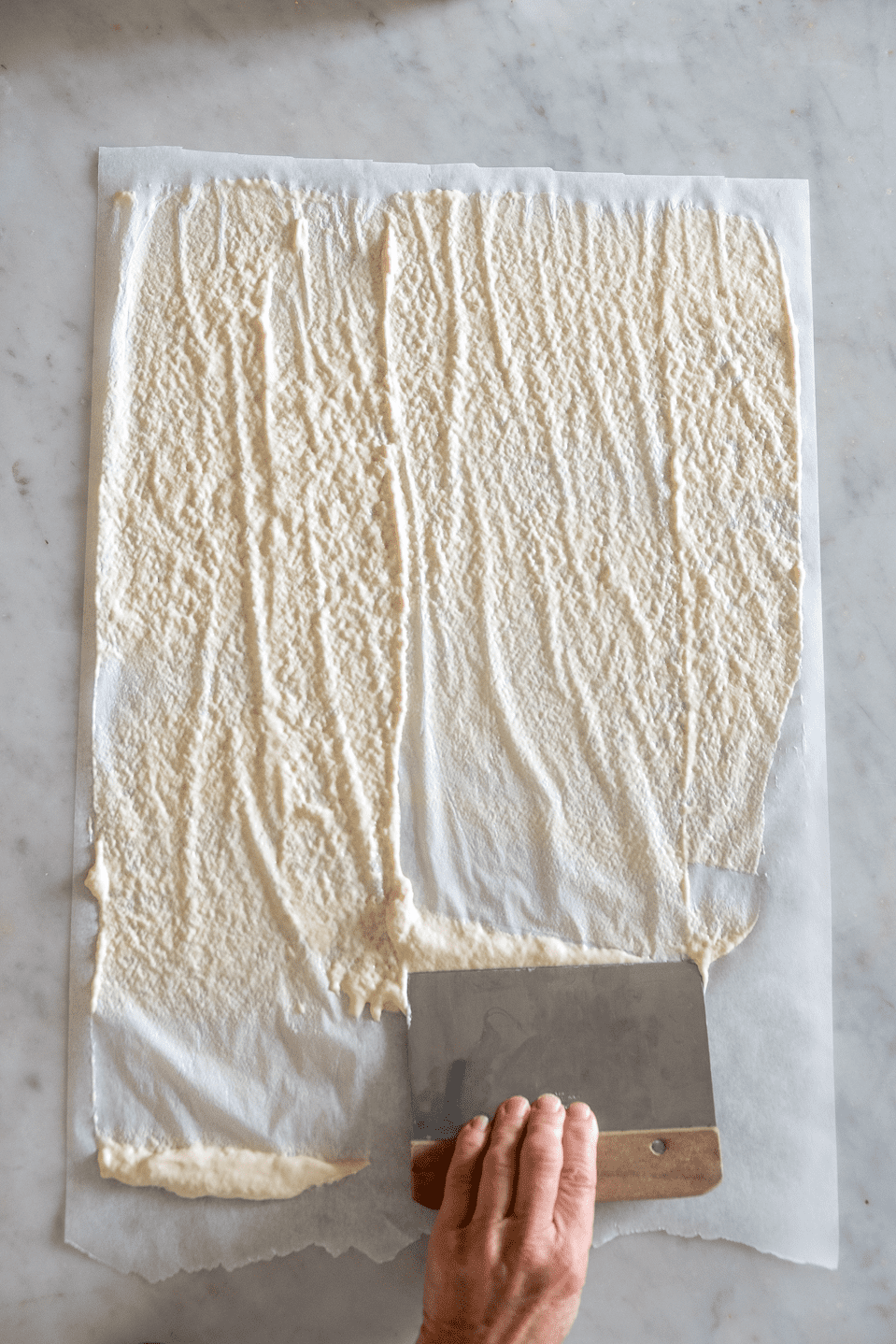
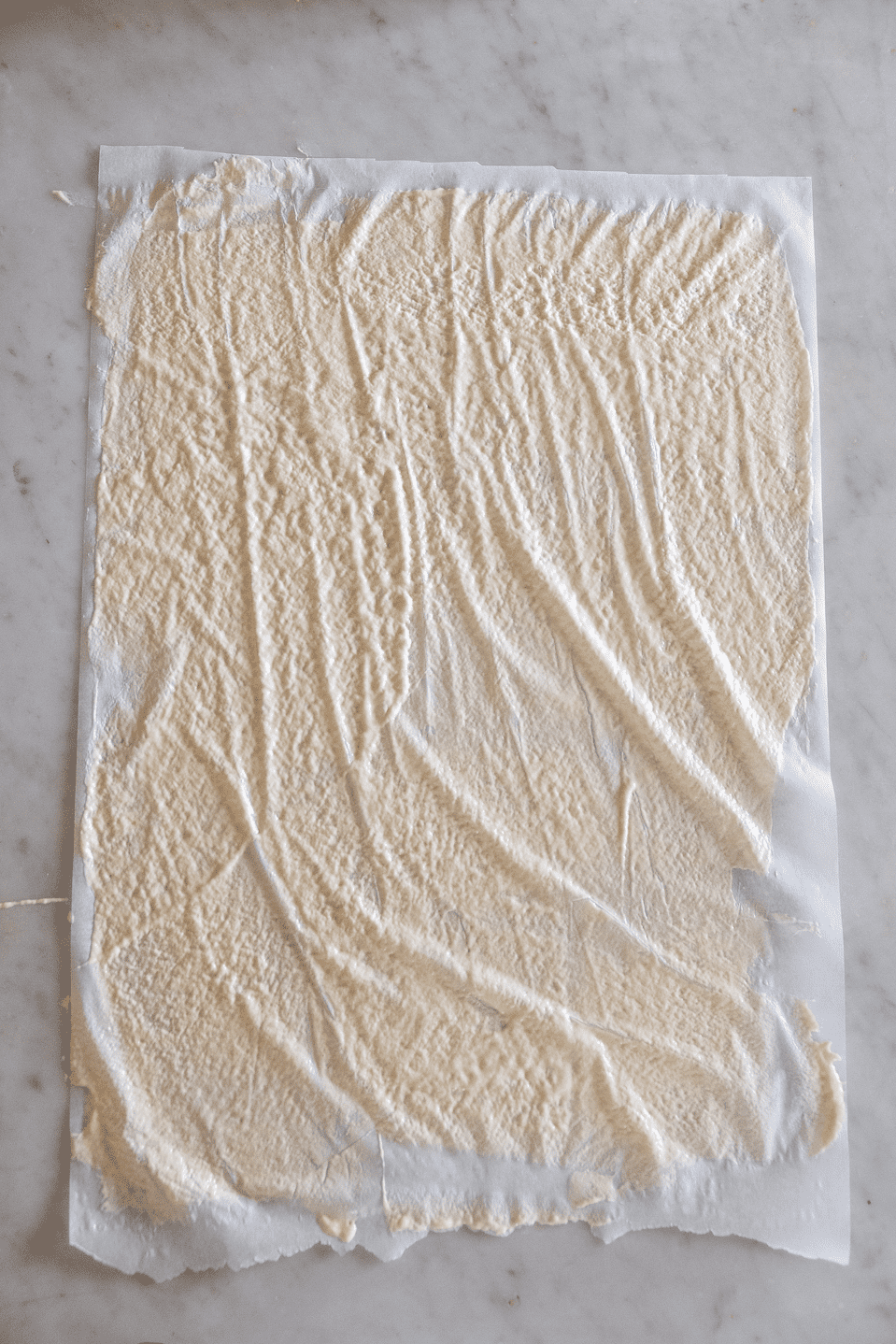
The parchment will get wet and wrinkly and you'll worry. Don't. It's fine. Within hours the starter will start to dry and lift up from the parchment.
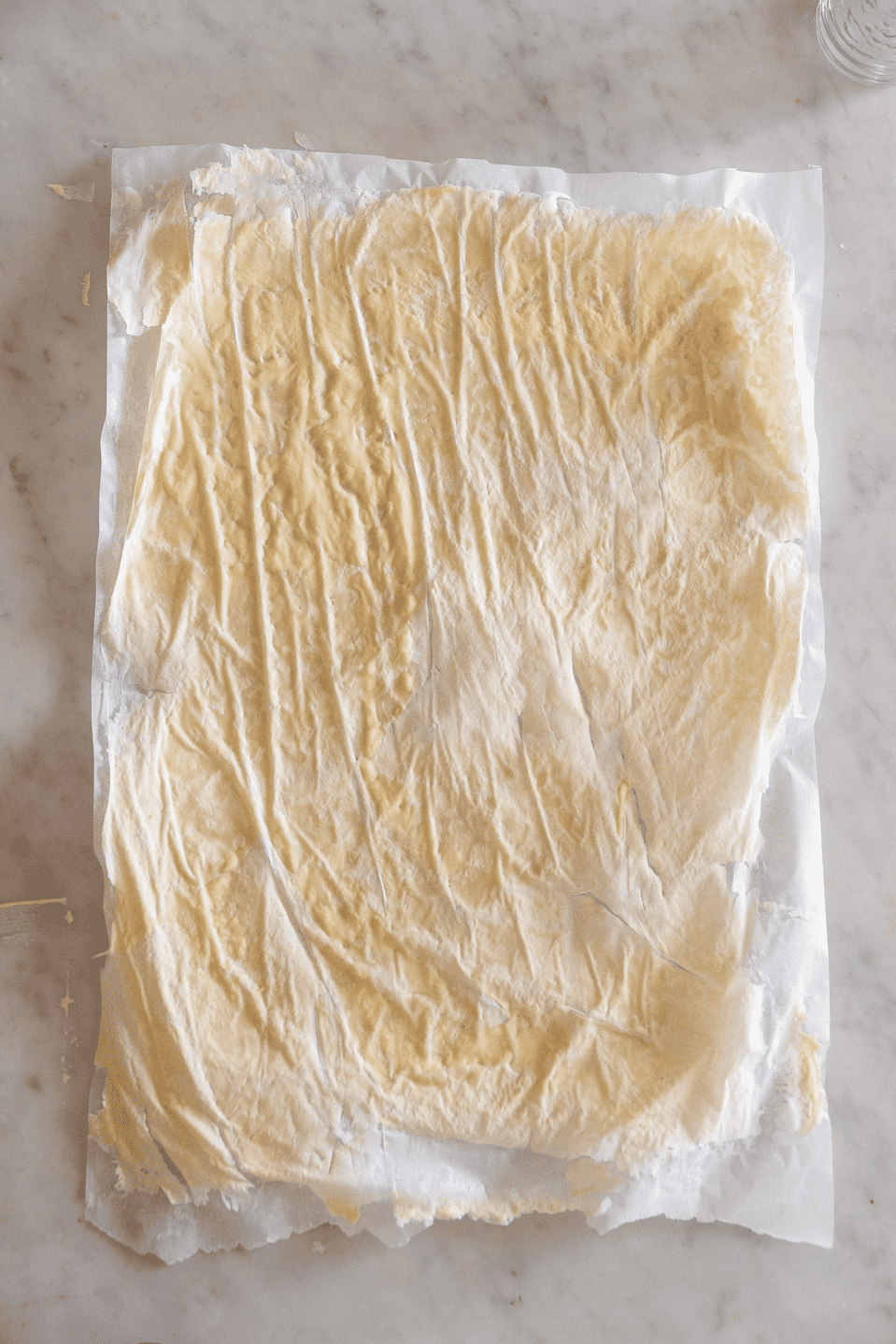
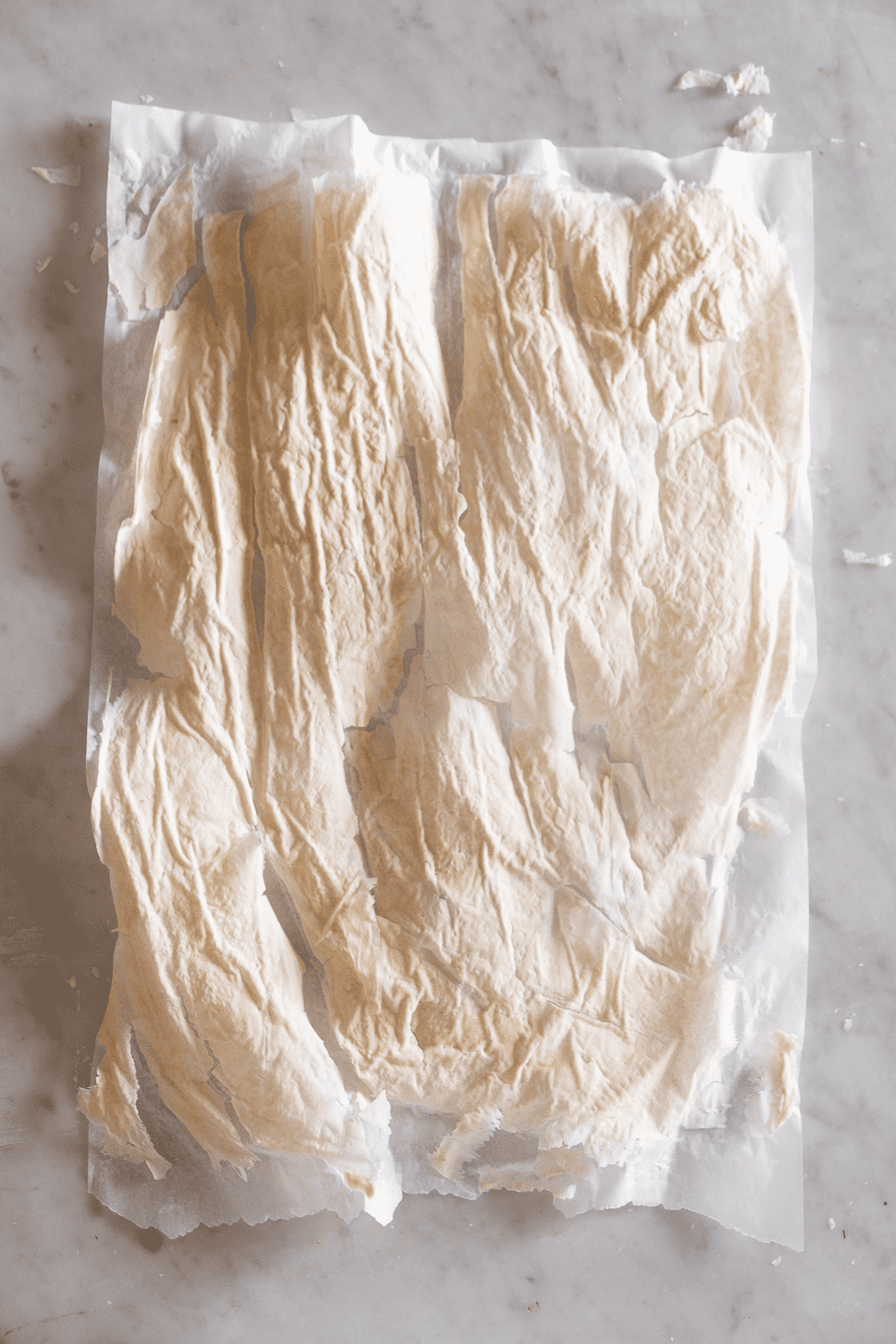
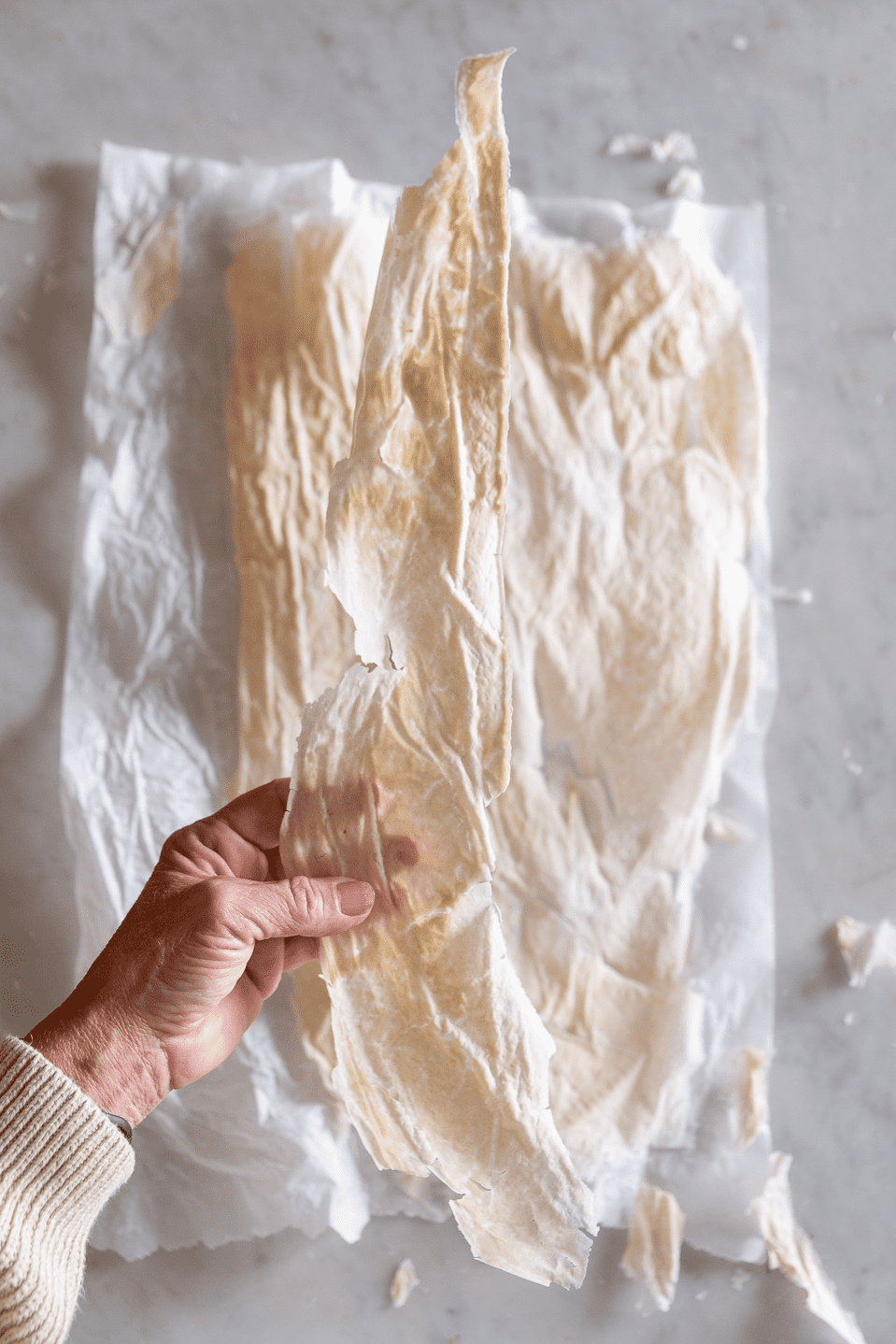
Drying starter in a dehydrator
- Set dehydrator to a temperature of 90℉ (32°C). If your dehydrator doesn't go that low just make sure the temperature is 100℉ (38°C) or below. Yeast dies at 140℉ and is damaged at temperatures lower than that. You don't want to risk killing the yeast.
- After spreading starter in a thin layer over parchment paper, place it into your dehydrator. If you have these special Excalibur dehydrator sheets like you might have seen in my how to make fruit leather post they work great for drying sourdough starter.
- Run the dehydrator for a few hours then check the starter to see if it's brittle. Once completely dry and brittle remove it from the dehydrator.
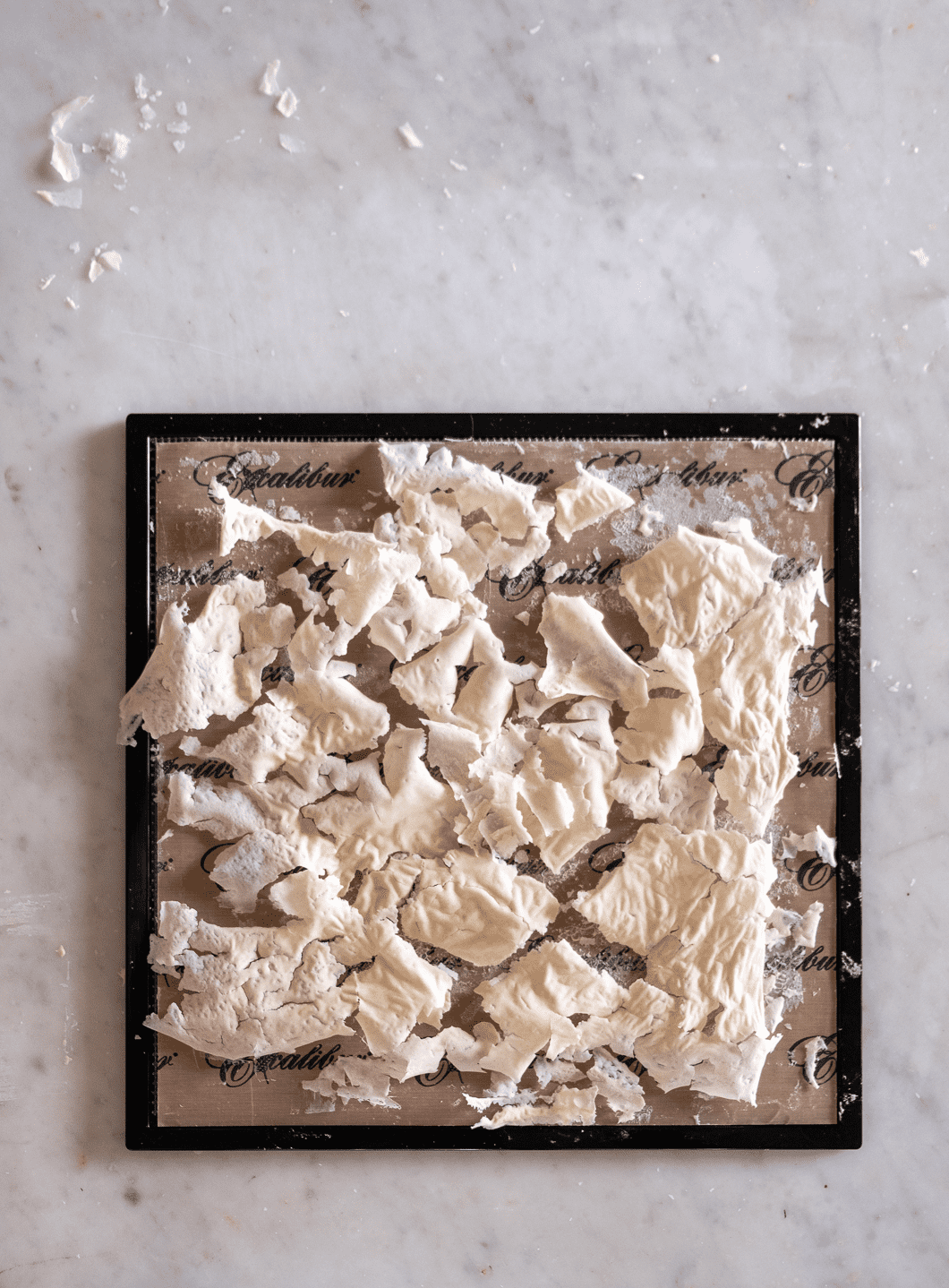
Storing dried starter
Your dehydrated starter is now safe for long term storage or voyage. Keep it for yourself or mail it to friends.
Would you like to save this stuff?
- Break the sheets of dried starter into shards and put them in a blender or food processor.*
- Process until the starter has turned into a powder like consistency.
- Leave the lid on your blender for a couple of minutes to let the powder settle down then pour it into a mason jar. Cover tightly and keep it in a cupboard at room temperature.
*You can also skip the blender and put whole shards in a mason jar. The shards have to be crushed before activating later.
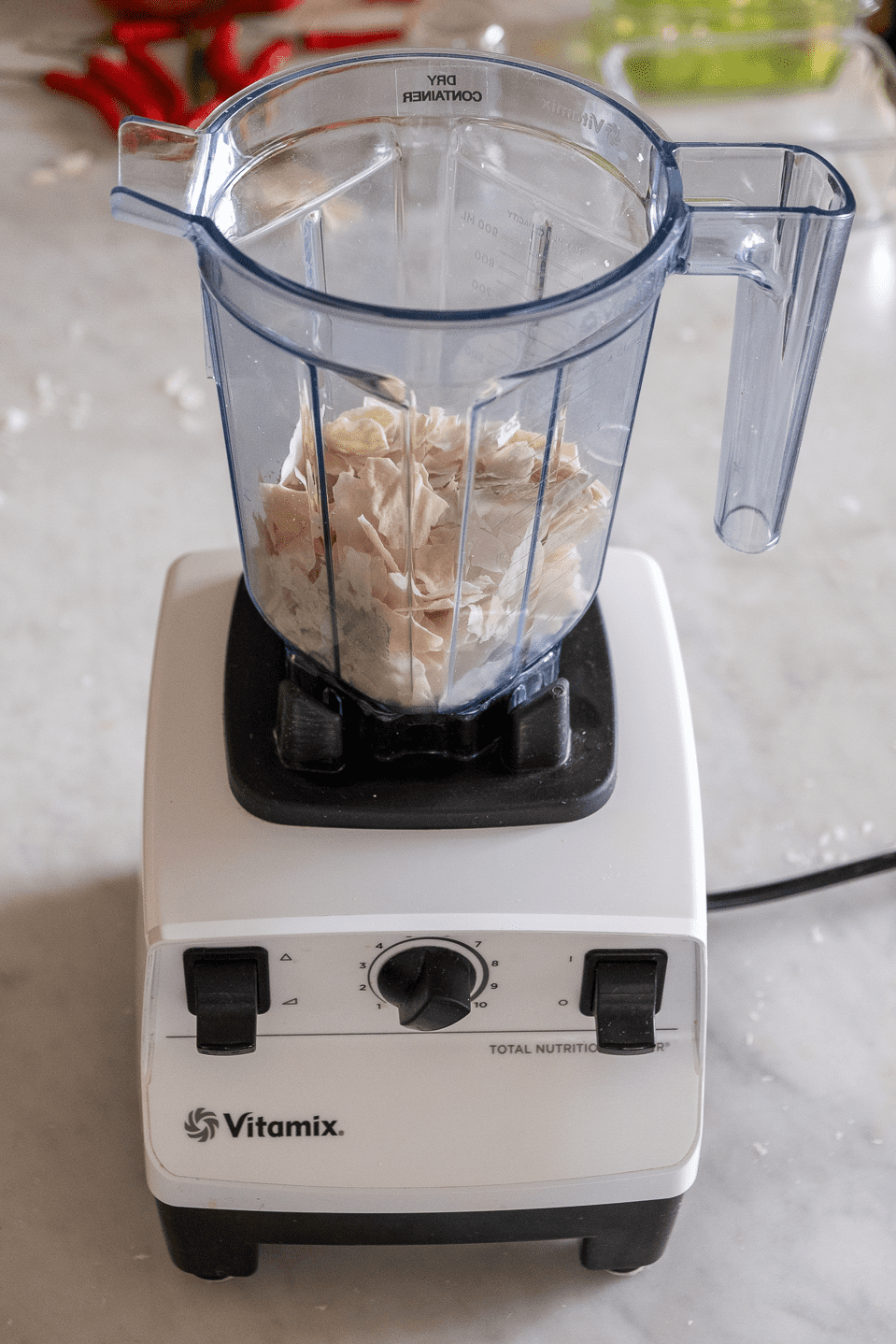

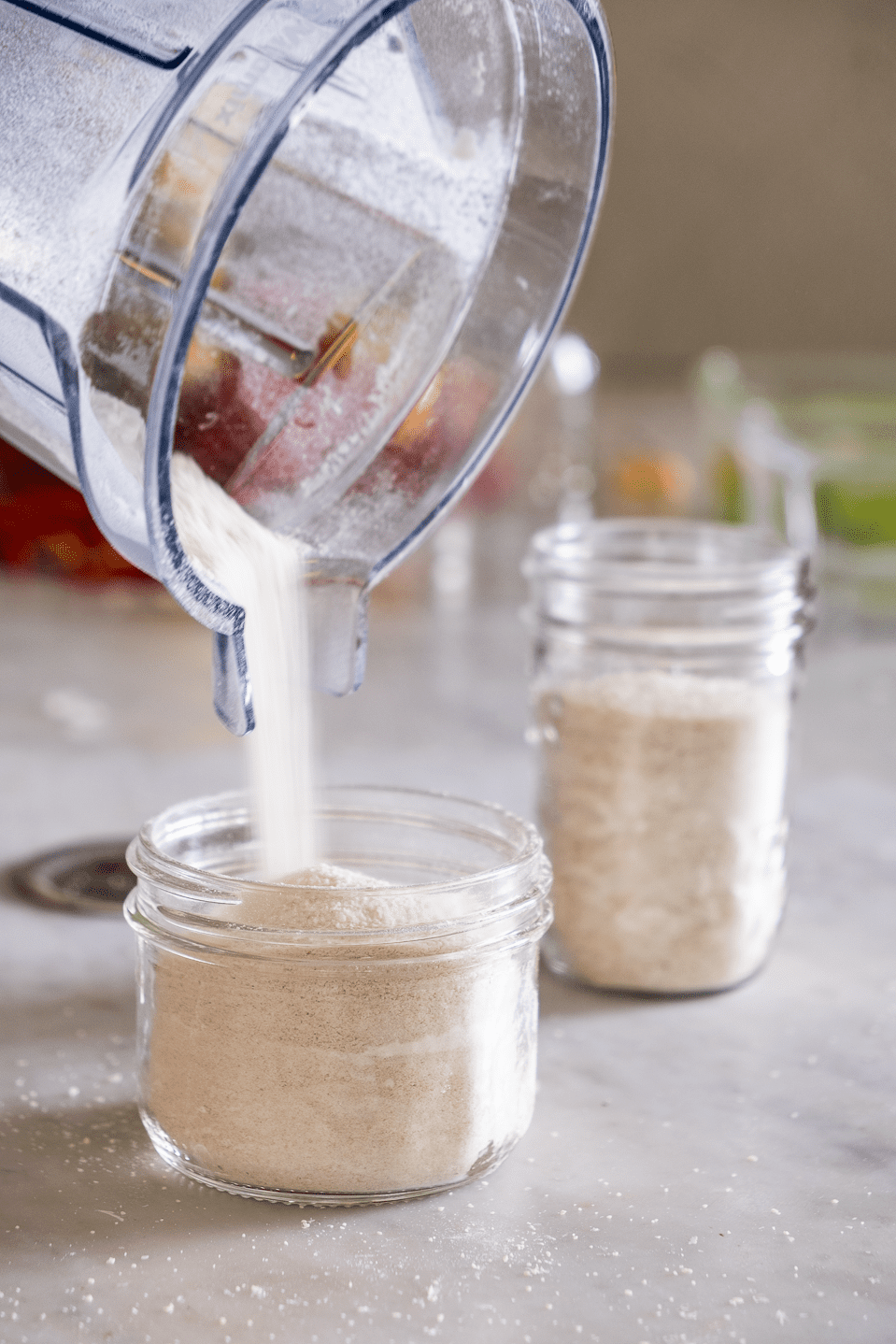
It only takes a few grams of dried starter to make a whole large mason jar of very active sourdough starter like this.
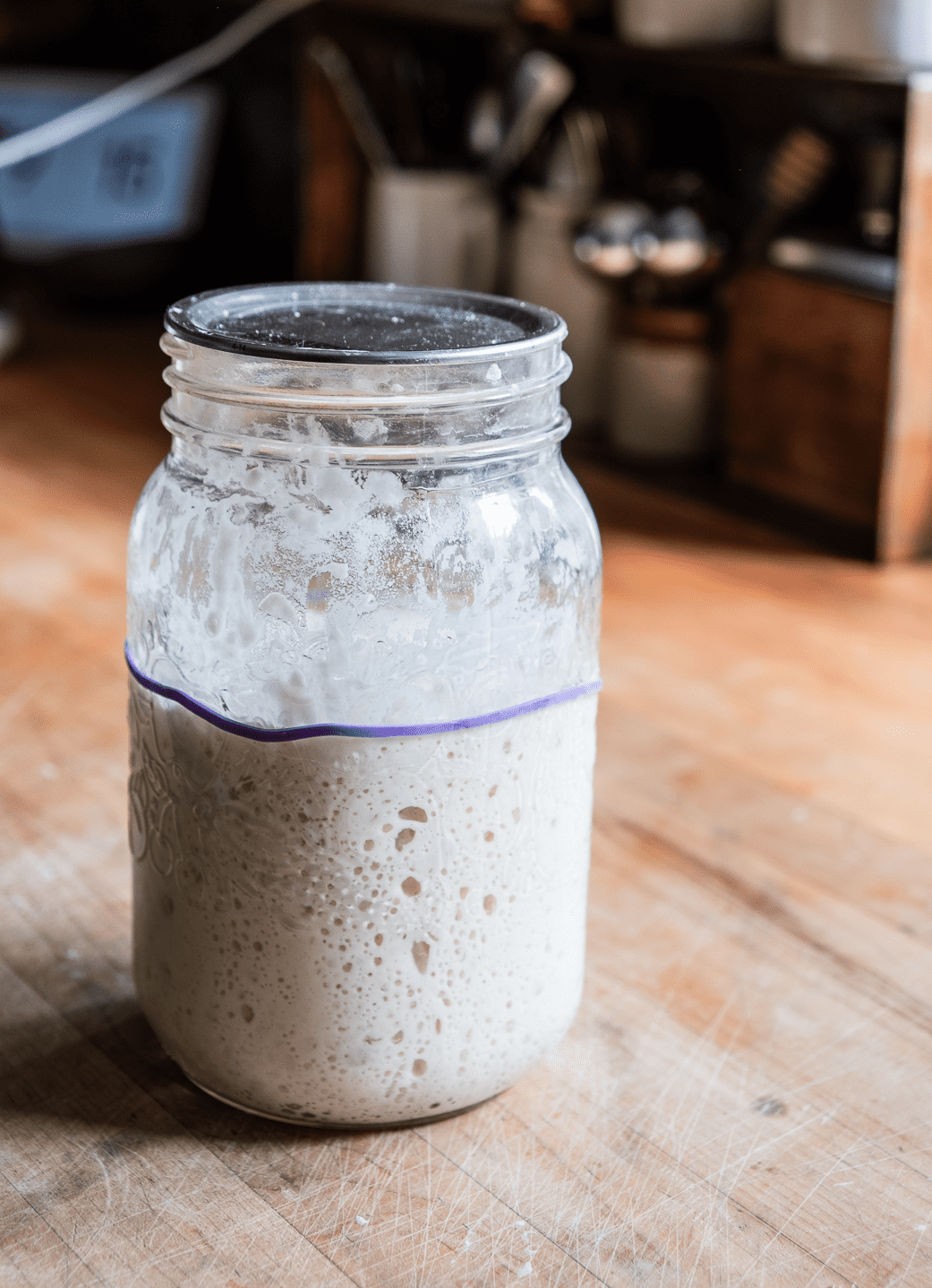
How to revive dried starter
Using all purpose flour and room temperature water.
Day 1
Mix 1 heaping teaspoon (6-8 grams) of dried starter with 1 tablespoon of lukewarm water to soften. Stir in 1 tablespoon of flour. Cover with plastic wrap and let sit on the counter for 24 hours.
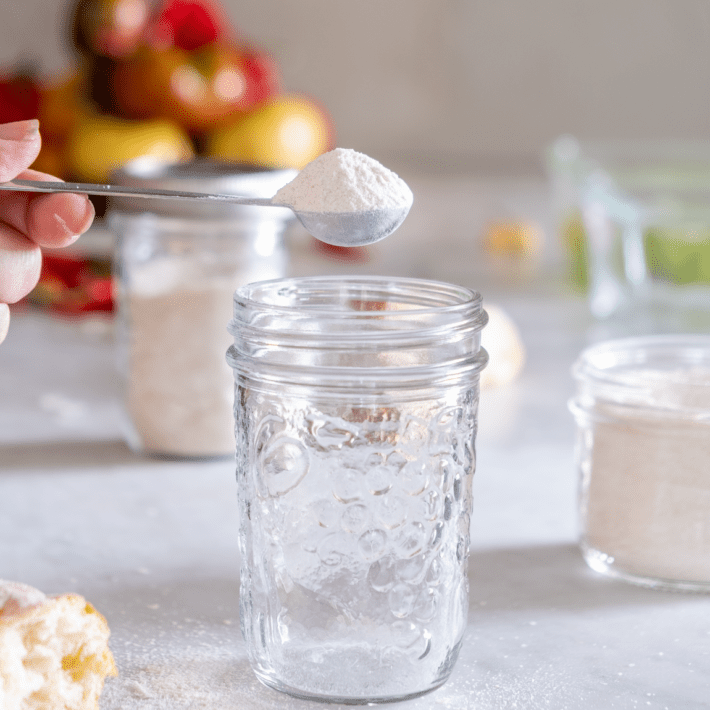
Day 2
Stir in 1 tablespoon of flour & 2 teaspoons of water. The mixture will be stiff, not runny. Cover and let sit 24 hours.
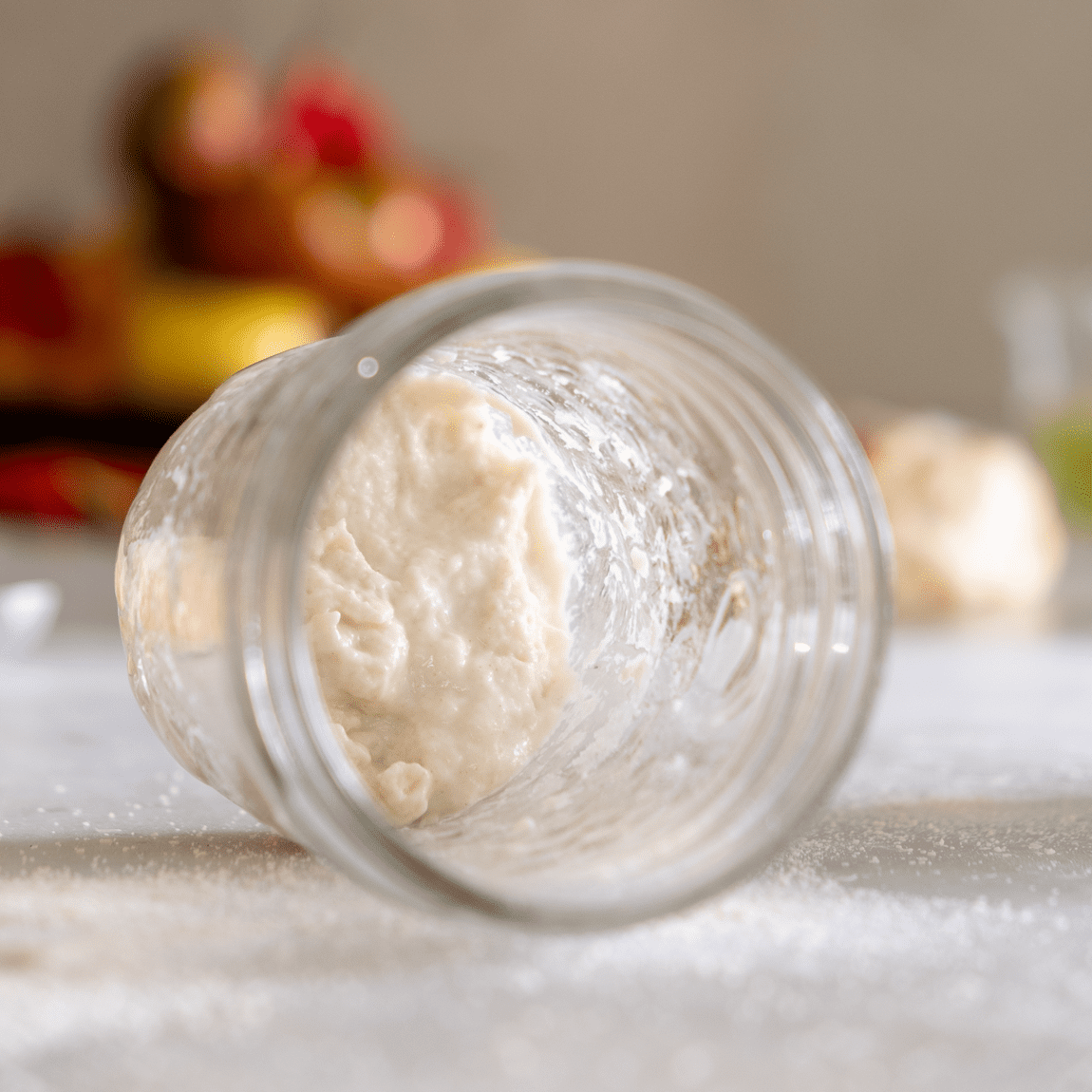
Day 3
Stir in 1 tablespoon of flour & 1 teaspoon of water. Bubbles might start forming now! Cover and let sit.
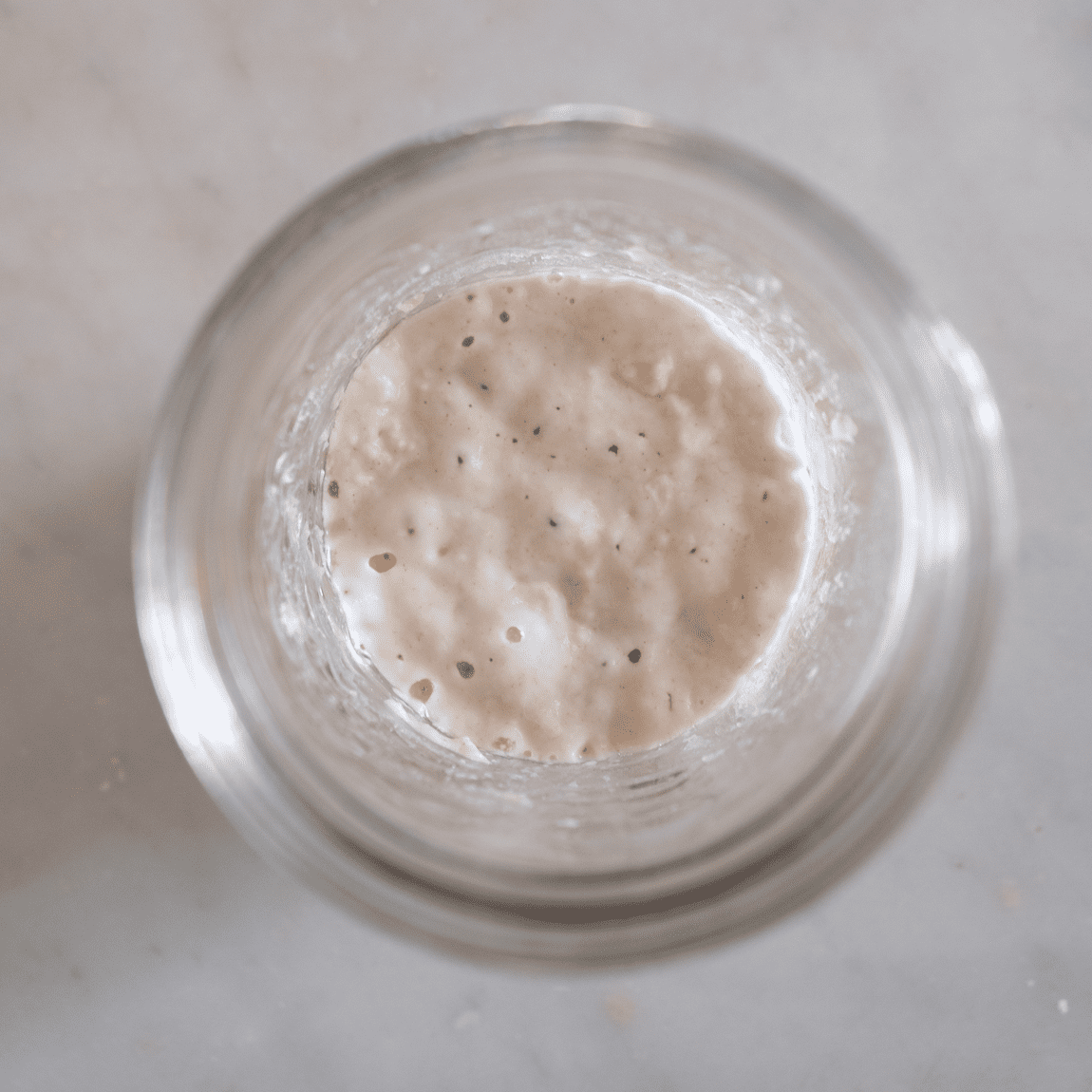
Day 4
Transfer the mixture to a 1 litre mason jar. Add ⅓ cup flour & ¼ cup water. Cover. Wrap an elastic band around the jar to mark the level of starter. Within 12 hours your starter should be spongey & full of bubbles.

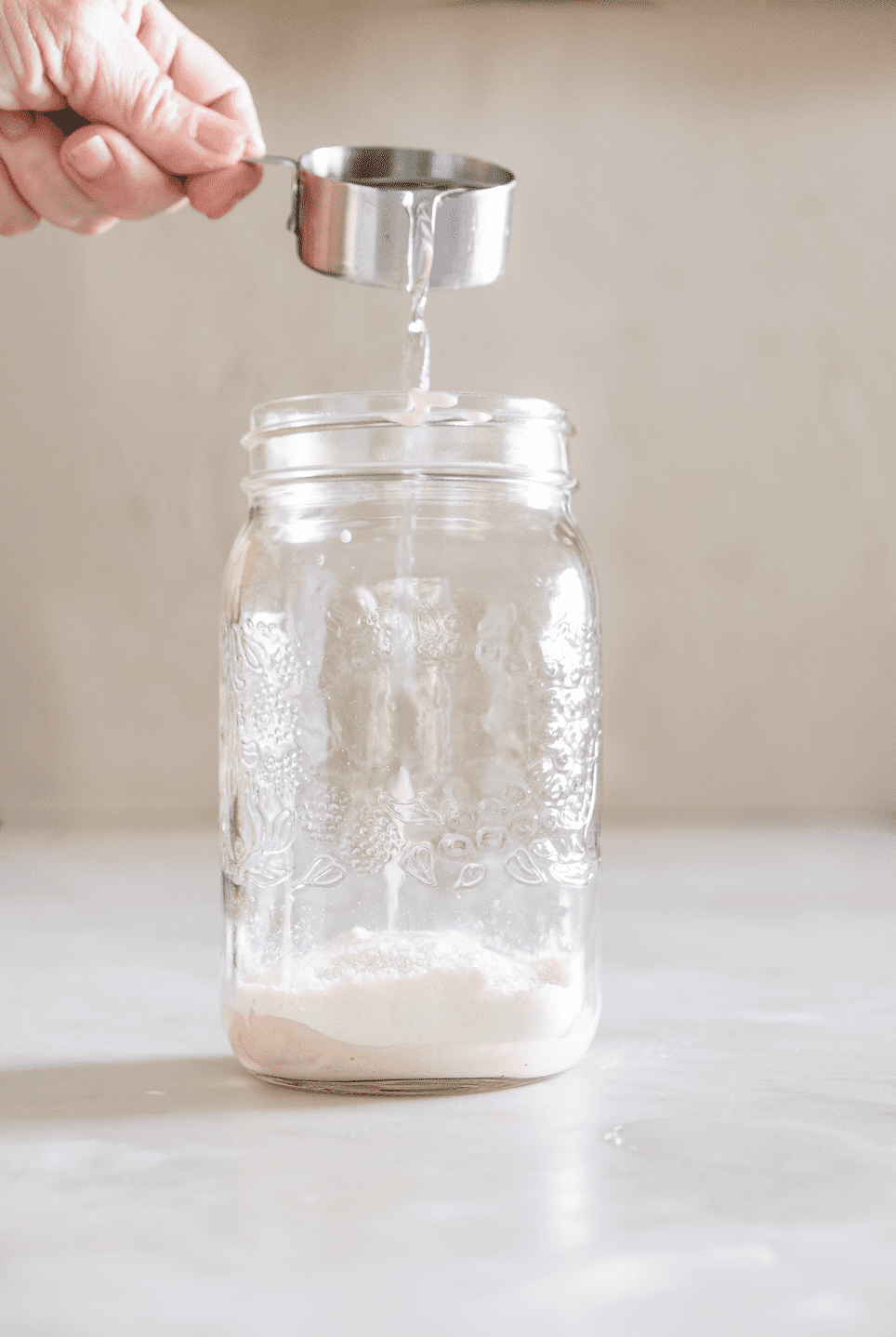
LOOK at what your dry sourdough starter becomes by day 4!
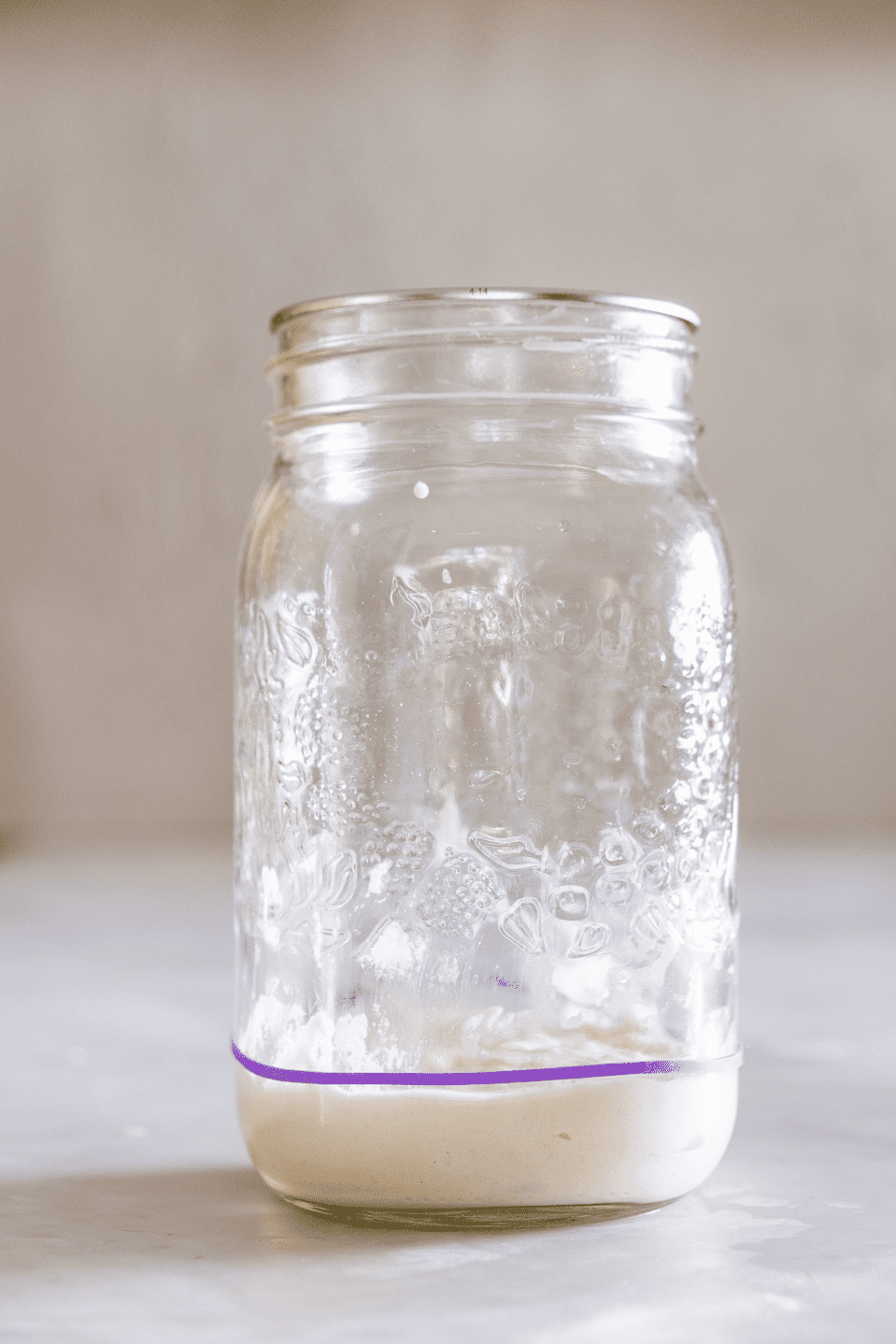
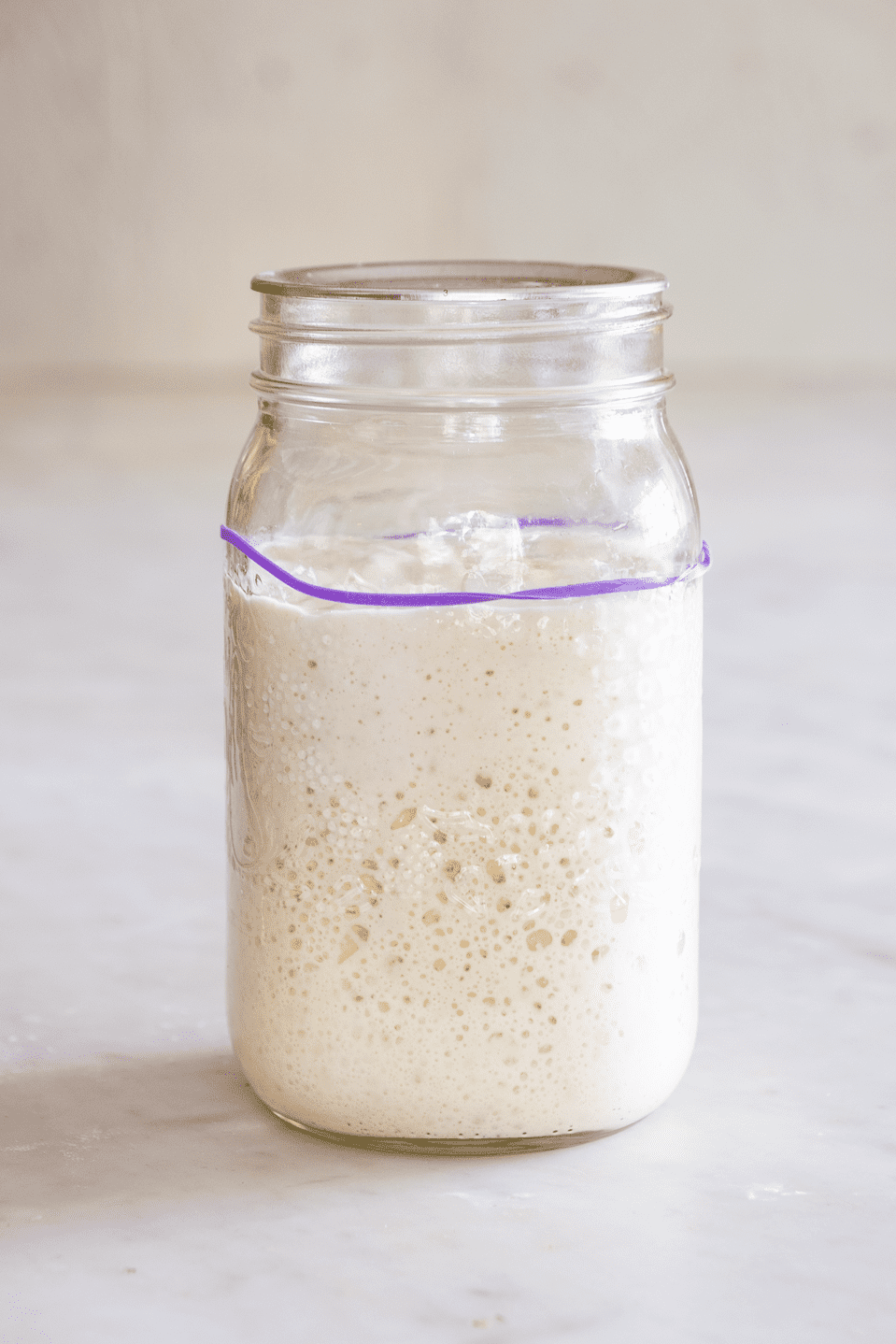
To maintain your activated starter mix equal weights of flour, starter and water. (50 grams of starter, with 50 grams of flour with 50 grams of water.
When you first start to build a liquid sourdough starter, rye is the best flour to use because it ferments easily and becomes strong and bubbly the quickest. The second best choice for making a liquid sourdough starter is whole wheat.
For activating DRY sourdough starter, you can use rye, whole wheat or regular white flour. King Arthur flour seems to have the most dedicated following in the US because with a protein content of 12-13% it's most similar to an All Purpose Canadian flour. In Canada, I use locally grown flours like Miller's Pride or Robin Hood unbleached All Purpose flour.
The water temperature you use will determine how quickly or slowly your starter develops.
USE ROOM TEMPERATURE WATER: Room temp. water is perfect for adding to your starter in most cases.
USE WARM WATER: If your house is cool (68℉ or so) or if you were late feeding your starter and want to speed the process up a bit.
You dehydrate it first. :) Then wrap up a heaping ½ teaspoon of it in plastic wrap or anything else that will keep it dry. It's so small and lightweight you won't even need extra postage.
Don't sweat it! Sourdough starter is incredibly resilient. Just pick up where you left off in the feeding schedule.
This focaccia was made 5 days after rehydrating my dry sourdough starter.

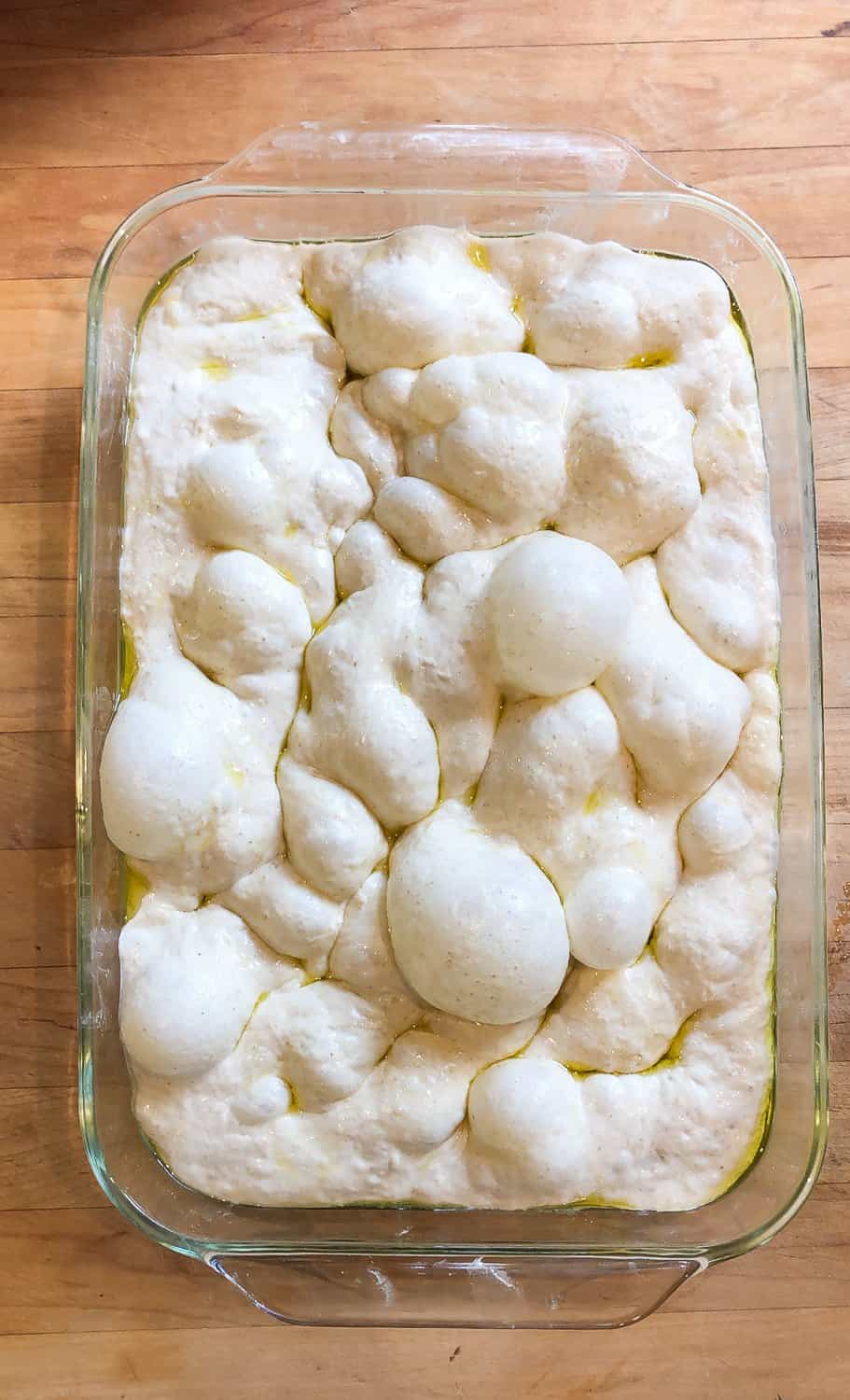
But you can also make bread, pizza dough, pancakes, or anything else you'd use a regular sourdough starter in.
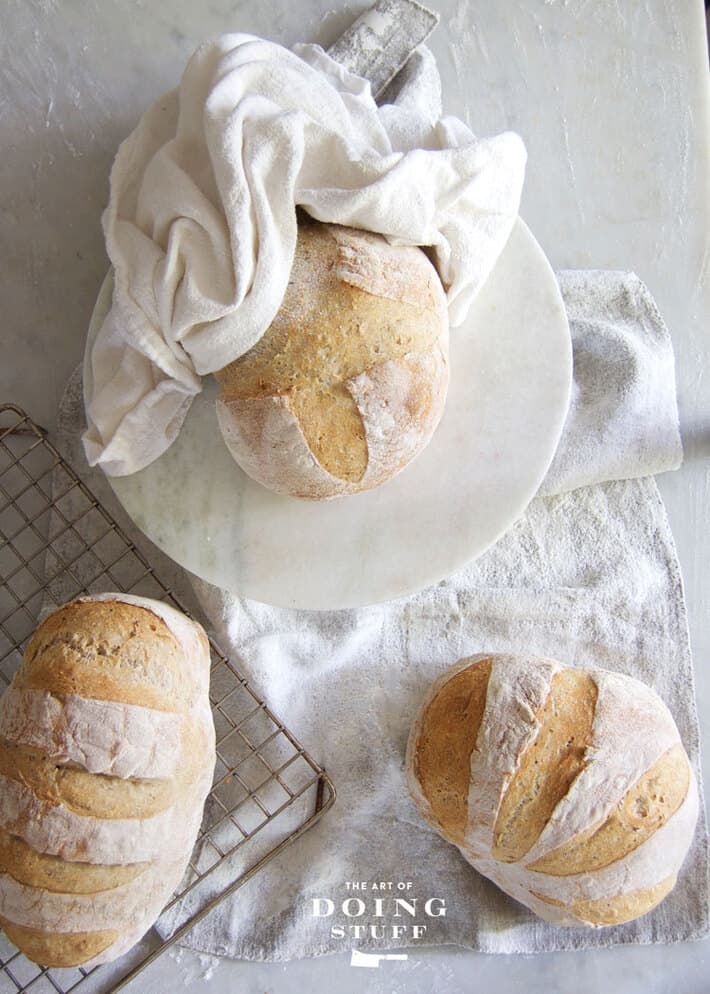
Now you can put your jar of powdered starter into the cupboard and completely ignore it like you normally do.
Only now it'll stay strong, won't go mouldy and not induce the guilt of a thousand Jewish-Italian mothers every time you think about it rotting behind the oyster sauce in your fridge.
→Follow me on Instagram where I often make a fool of myself←
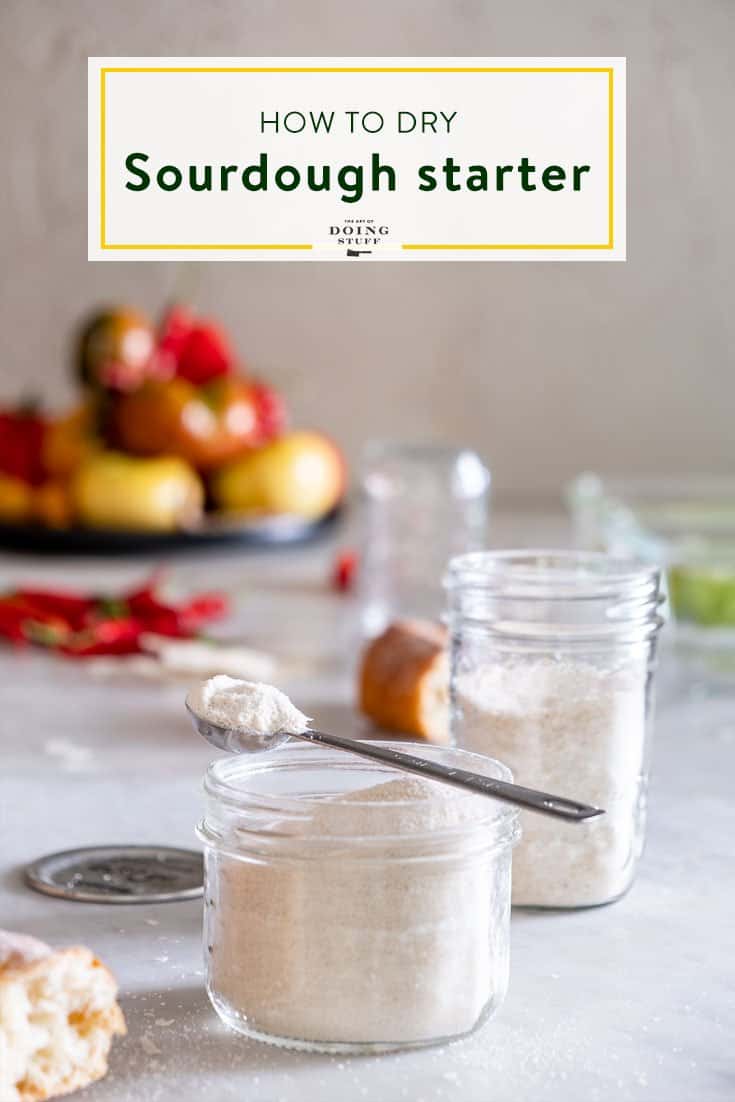





Julie
Is it bad to put the dried sourdough starter in the freezer?
Mary W
THANK YOU SO MUCH - My Karen is still doing fine but WOW what a 3 minute Panithias she is. You would think it was more like an hour or so each day but no - just 3 minutes. I think the Panithias comes from me having to think each day. She is still strong and flavorful. I usually use her for discard foccacia instead of bread. Just learned that the sour comes from the overnight ferment so I'm going to try making bread without that and see what happens. Made pancakes and they were great! I always wondered if it was as easy to dry as it seems to be and you came up with this most awesome post. I have also learned that the first pancake is always black just like normal but is an excellent place to smear out my discard - then give to the birds, they ADORE it.
Karen
Glad to hear I'm still alive and well! ~ karen
Leslie Barnard
This is great! One question- Have you made sourdough pizza crust? I know I could look it up but I trust you more than some random pizza-making, self-proclaimed expert. Just wondering if you have a reliable recipe. BTW, Joy of Cooking has a sourdough chocolate cake that I have made twice now (I add more chocolate into the batter and make a bittersweet ganache icing for it) and it's goooood. Too good.
Karen
Hi Leslie! That *does* sound good. And I have that book ... somewhere. I have made sourdough pizza crust but I haven't done it in so long that I forget what recipe I used! If you're looking at photos on blogs deciding which recipe to use, look for a crust that looks like mine. With big airy bubbles in the cornicione (outer crust). ~ karen!
Carla
King Arthur has a great recipe for sourdough pizza, I love it!
BTW, thank you for the detailed instructions for reviving dehydrated sourdough. I had some that was a few ears in my pantry & I think that now after day 3 of feeding it will be revived by tomorrow! I’m reviving it for a friend.
Jane
What an interesting idea! I bake a few times a month, so there's no concern about my starter, but being able to give away as gift appeals to me. Before I realized that I can make kefir with kefir, I used to dry the excess kefir grains (you can only give away so much), grind them up, and sprinkle on food. Wonder if it's possible to revive kefir grain powder this way. Thanks, Karen!
BTW, I add oyster sauce to marinades, enhance umami.
Linnea
Thank you thank you for sharing this, this is so gonna come in handy!
Kim
This is now on my To Do list for this week. I have some backup starter in the freezer but this is a better, more long-term backup. BTW, you don't have to feed your starter regularly. I swear by Elaine Boddy for everything sourdough, keeping my 50 - 100g of starter in the fridge and only feeding it when I want to bake. Might take a couple of feedings before it's ready if it's been neglected a long time but starter really can be much less maintenance than most people realize. And the layer of hooch that forms on top (showing it's hungry) can be stirred right in to add flavour, or can be poured off or added to a discard jar of starter.
Karen
HI Kim, yes you can absolutely keep your starter in the fridge! But you still do have to feed it for a few days before using it to get it back in action. So personally, I find it easier to just leave the starter on the counter and feed it a little bit every day. That way it's ready to go whenever the urge to make bread strikes me. :) ~ karen!
Kim
I bake every week or two and keep my starter in the fridge and just one feeding the day I want to assemble the dough is all it takes to bring it back to its bubbly happy self within about 4 - 5 hours at room temp (and quicker if I put it in the oven with a light on). It can sit in the fridge covered and untouched for several weeks and be well-revived with just a couple of feedings. This was a game changer for me. I have so little discard now that I have to purposely feed my starter extra to make pancakes and other recipes calling for discard.
Karen
I'll give it a shot! ~ karen
Randy P
Thank you for this valuable info - simply wonderful to know. The danger inherent in something like Amish "Friendship" cake is how easy it is to make enemies struggling to keep up with your vast production of starter that HAS TO BE USED QUICKLY. I like to keep in shape - Hey! round IS a shape - by striving to learn the art of bread making. And sourdough is a favorite.
Nancy Ann
Funny, Randy.